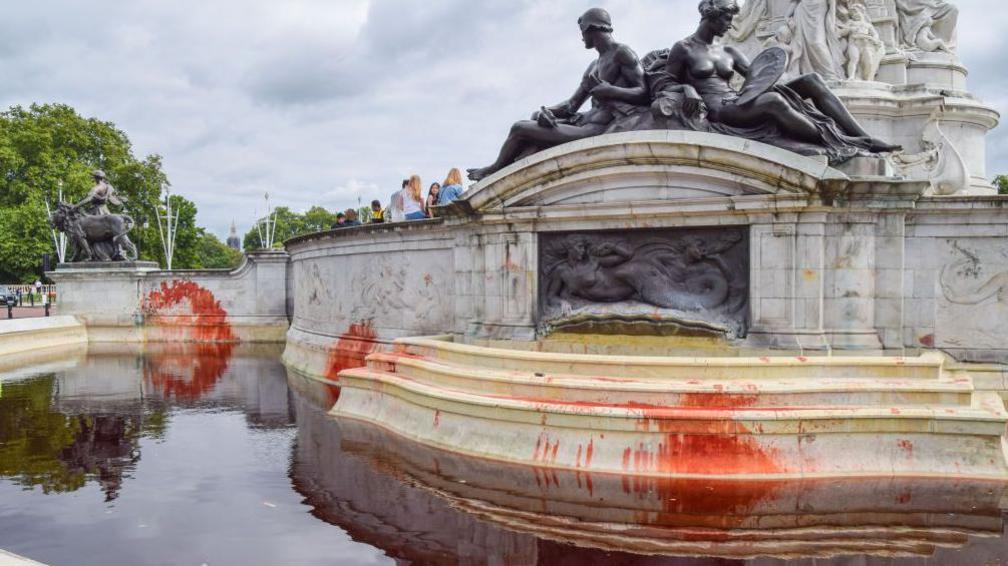Palace fountain protest caused £7k of damage - court

The defendants are accused of damaging the Victoria Memorial fountain with fake blood
- Published
A group of Animal Rebellion protesters caused thousands of pounds worth of damage to a Buckingham Palace fountain by releasing red dye into it, a jury has heard.
Louis McKechnie, 23, Christopher Bennett, 27, Riley Ings, 27, Claire Smith, 26, and Rachel Steele, 48, appeared at Southwark Crown Court on Wednesday.
They are accused of causing more than £7,000 of criminal damage to the Victoria Memorial water feature on 26 August 2021.
The group, who all deny the charge, staged the protest at the Grade I listed fountain, which sits directly in front of the royal London residence.
Ailsa McKeon, prosecuting, said the dye had not only turned the water red, but also stained the stonework of the fountain.
She said CCTV footage showed a number of the protesters dyeing their hands and then leaving red handprints on the stonework of the fountain.
"They are being prosecuted for causing thousands of pounds of damage to a public memorial," she said.
The court heard the estimated cost to repair the fountain was £7,080.24.
Michael Robert Turner, who was an assistant manager for Royal Parks at the time of the protest, told the jury the fountain is normally cleaned once a month, but emergency repairs had been carried out.

The memorial is a centrepiece outside Buckingham Palace
Shina Animashaun, defending Mr Ings, Mr McKechnie and Ms Smith, asked Mr Turner why the water feature had required the emergency clean - which costs extra - instead of just being cleaned on a routine basis.
"The key thing about this is that the marble is porous," he replied, adding that if the marble had not been cleaned immediately it risked the dye seeping in and staining the stone.
Mr Ings, who gave evidence to the court, was asked what he believed would happen after the dye was released into the fountain.
"That it would simply leave a mark that would wash away," he said.
He added that he did not consider that the dye would not clean off.
"I did not believe that there would be damage at any point," Mr Ings said.
He said he accepted that the water feature was cleaned, but he did not accept that cleaning amounted to proof of criminal damage.
Mr Bennett, of Fish Ponds Road, Bristol, Mr Ings, of no fixed address, Mr McKechnie, of Claremont Road, Dorset, Ms Steele, of Capworth Street, east London, and Ms Smith, of Chadwick Street, Leeds, each deny one count of criminal damage.
The trial continues.
Listen to the best of BBC Radio London on Sounds and follow BBC London on Facebook, external, X, external and Instagram, external. Send your story ideas to hello.bbclondon@bbc.co.uk, external